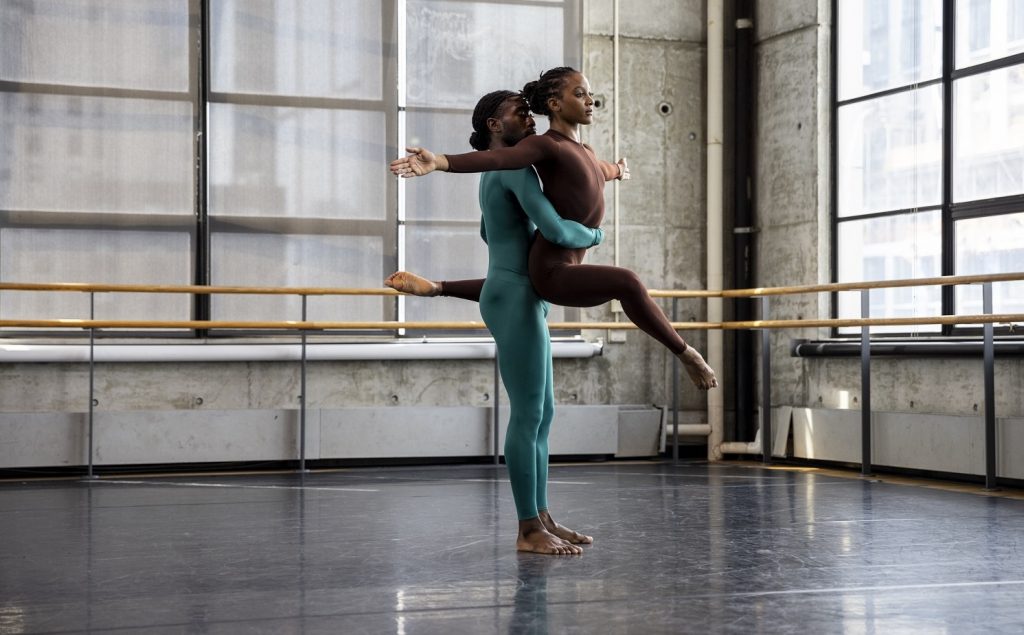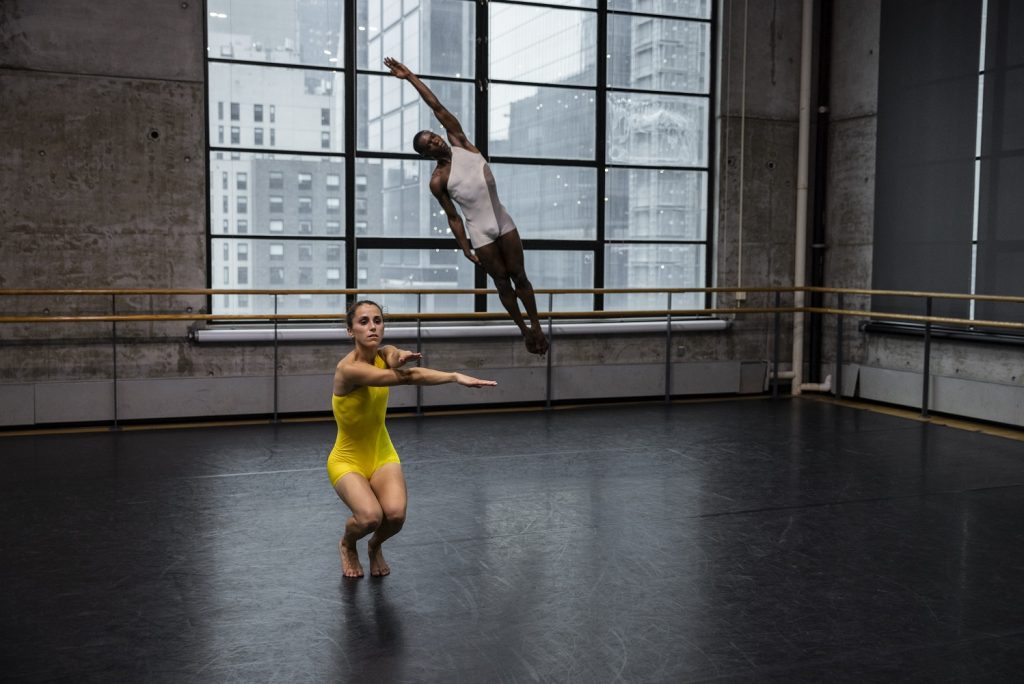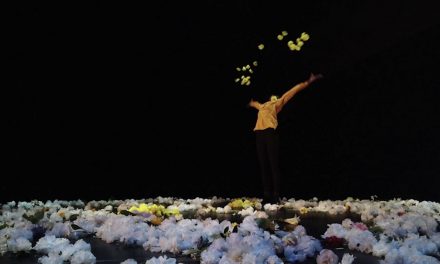For decades now, choreographers, musicians and artists around the world have reaped the rewards of moving through artistic doors made accessible by Merce Cunningham, John Cage, David Tudor, Robert Rauschenberg and Jasper Johns. On Monday, September 27, 2021 I watched In Conversation With Merce which featured an arrangement of solos and duets from Cunningham’s 1972 work titled Landrover, and the world premieres of Dialogue by Liz Gerring and MotorRover by Kyle Abraham, each commissioned by the Baryshnikov Arts Center (BAC). This amazingly unpretentious but beautiful film was Co-Presented by BAC and the Merce Cunningham Trust and recorded in the spacious BAC’s John Cage and Merce Cunningham Studio. The film is available free HERE but only until September 30th. Hopefully, it will live online or in the BAC and Cunningham Trust’s archives for years to come.
According to former Cunningham Company member and Cunningham Trustee Patricia Lent, this was the third realization of an idea that the Cunningham Trust began experimenting with during Cunningham’s centennial year. Lucky for us, it will not be the last.
The first In Conversation was conceived and curated by former Cunningham Company member Rashaun Mitchell which featured three new works by choreographers Moriah Evans, Mina Nishimura, and Netta Yerushalmy. The three female dance artists created their work in response to or “in conversation” with Merce Cunningham and his work. The second in this series was a collaboration with Hope Mohr Dance and ODC/Dance Company in San Francisco. It was a two-week workshop that culminated in performance featuring excerpts from Cunningham’s work, with the new works created by each of the commissioned artists. You can view “Signals From the West: Bay Area Artists in Conversation with Merce Cunningham” HERE.
The In Conversation With Merce that I watched included an introduction by Patricia Lent and very brief pre-showing statements by choreographers Gerring and Abraham. The film run time is 44 minutes, most of which is dancing.

“Landrover” by Merce Cunningham – Dancers Jacquelin Harris (brown costume) and Chalvar Monteiro (teal costume) – Photo by Maria Baranova
Performed with breathtaking technique, clarity and sensitivity to the choreography by Jacquelin Harris and Chalvar Monteiro, the duets presented from Cunningham’s Landrover, staged here by former Cunningham company member Jamie Scott, included a romanticism rarely seen in his work. It was abstract and fleeting, but it was there. Was this due to the close proximity of the cameras or simply the relationship between the two dancers.
The movement in Landrover was filled with Cunningham’s signature movements, his brilliant sculpturing of bodies and a bare boned athleticism, but throughout there was a sensuality in the ways the Harris and Monteiro related; how their arms connected, and how Monteiro inhaled Harris’s essence before lifting her. It has been a while since I have seen the humanity in Cunningham’s work performed this way and it was indeed a long awaited treat. In full disclosure, I performed with the company for three years, 1967-1970, when Cunningham was still performing in every work.
The music, composed by John King and Anaïs Maviel, was filled with haunting vocals and echoed the complex simplicity of Cunningham’s choreography. The costumes were based on the original design by Jasper Johns and reconstructed by Reid Bartelme and Harriet Jung.

World Premiere Choreographed by Liz Gerring – Dancers Mariah Anton (yellow costume) and Cemiyon Barber (white costume) – Photos by Maria Baranova
In Dialogue, Liz Gerring captures Cunningham’s sense of space and time. She mentioned in her introduction that she first saw a Cunningham performance when she was a teenager living in Los Angeles, and that she has been having an internal artistic conversation with Cunningham ever since. It was that concert that Gerring realized that dance is what she wanted to do as a career. Gerring is currently the Executive Director and Choreographer of the New York based Liz Gerring Dance Company.
Like in the duets in Landrover, the two dancers in Dialogue share the space, they are connected but Gerring more often keeps them separated. The two dancers, Mariah Anton and Cemiyon Barber, are amazing but what was missing was a personal or human connection. The movement was extremely physical and Gerring’s choreography was exciting and utilized brief glimpses of Cunningham shapes, but as a conversation with the master, it lacked Cunningham’s gift of stillness.
Michael Schumacher’s music for Dialogue captured the Cunningham musical era quite brilliantly and it was very compelling. The rehearsal assistant was Jamie Scott and the very appropriate costumes were by Reid Bartelme and Harriet Jung.

World Premiere Choreographed by Kyle Abraham – Dancers: Claude “CJ” Johnson (short hair) and Donovan Reed (shaved head) – Photo by Maria Baranova
Kyle Abraham, Artistic Director of A.I.M. by Kyle Abraham, has created an extraordinary duet, MotorRover between two men, Claude “CJ” Johnson and Donovan Reed, that lives in harmony with all the positive elements of Cunningham’s work produced during the era that Landrover was made. The understated sensuality, the human and the movement connection between the dancers, as well as his use of stillness that speaks volumes. Even the costumes by Bartelme and Jung unite these two brilliant performers in their choice of fabric and muted colors. The costumes move, but do not distract. They connect but each would work in a solo.
Abraham has a unique and powerful choreographic voice of his own, but in MotorRover, he was speaking directly to Cunningham. His only connection to the Cunningham technique was while studying with former Cunningham member Kathy Kerr at SUNY Purchase. It is obvious, however, that over the years Abraham has witnessed and understands the genius of Merce Cunningham.
Performed in silence, MotorRover also converses with John Cage. One hears the sounds of the dancers feet on the studio floor, their breathing, the distant sounds of New York outside the studio walls, and the non-silent silence of the studio itself. MotorRover is loving. It is extremely human and it is breathtakingly beautiful. I wanted more.
To view In Conversation With Merce before September 30, 2021, click HERE.
Written by Jeff Slayton for LA Dance Chronicle.
Featured image: Claude “CJ” Johnson and Donovan Reed in Kyle Abraham’s MotorRover – In Conversation With Merce” – Photo by Maria Baranova








